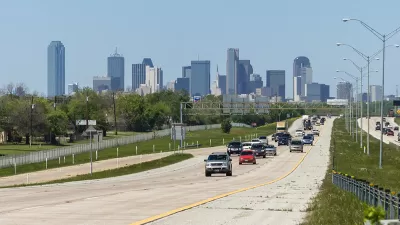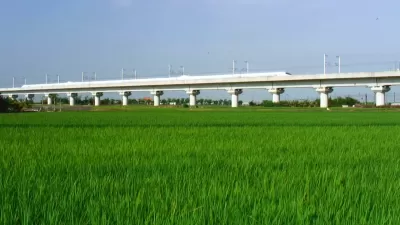Regional planners and Dallas officials aren't confident that the area's highway-centric worldview (and budget) will change anytime soon. The city's competitiveness in the national job market may be on the line.

While Dallas has taken some steps to build out its transit grid, the region as a whole is still firmly situated in what one city councilman calls "transportation planning right out of the 1950s." Here, Brandon Formby discusses why North Texas' transportation planning seems stuck in a mode that favors intensive road construction.
Despite aiming to "give people alternatives to driving everywhere solo," the North Central Texas Council of Governments' Mobility 2045 plan is heavy on the highways. "Less than 3 percent of the $42.9 billion in traditional federal and state transportation revenues in the plan goes toward projects built for pedestrians and bicyclists; less than 1 percent goes toward public transit."
One prevalent problem is the fact that current behavior must be used to predict future needs, even when it's impossible to know how people will want to get around thirty years from now. Are young people driving because they want to, or because they "have had to etch out their lives atop metropolitan areas that were built around the automobile long before they were born?"
Meanwhile, "with no major geographic barriers like mountain chains or an ocean on the North Texas landscape, there are few natural obstacles to restrict the region's sprawl." Officials expect the familiar pattern of road construction and suburban development to continue.
See also: Highway Expansion Could Be Calamitous for Dallas' City Center
FULL STORY: Will Dallas Ever Favor the Neighborhood Over the Highway?

Planetizen Federal Action Tracker
A weekly monitor of how Trump’s orders and actions are impacting planners and planning in America.

Chicago’s Ghost Rails
Just beneath the surface of the modern city lie the remnants of its expansive early 20th-century streetcar system.

San Antonio and Austin are Fusing Into one Massive Megaregion
The region spanning the two central Texas cities is growing fast, posing challenges for local infrastructure and water supplies.

Since Zion's Shuttles Went Electric “The Smog is Gone”
Visitors to Zion National Park can enjoy the canyon via the nation’s first fully electric park shuttle system.

Trump Distributing DOT Safety Funds at 1/10 Rate of Biden
Funds for Safe Streets and other transportation safety and equity programs are being held up by administrative reviews and conflicts with the Trump administration’s priorities.

German Cities Subsidize Taxis for Women Amid Wave of Violence
Free or low-cost taxi rides can help women navigate cities more safely, but critics say the programs don't address the root causes of violence against women.
Urban Design for Planners 1: Software Tools
This six-course series explores essential urban design concepts using open source software and equips planners with the tools they need to participate fully in the urban design process.
Planning for Universal Design
Learn the tools for implementing Universal Design in planning regulations.
planning NEXT
Appalachian Highlands Housing Partners
Mpact (founded as Rail~Volution)
City of Camden Redevelopment Agency
City of Astoria
City of Portland
City of Laramie





























